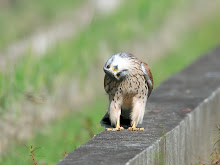Sunday, March 14, 2010
Molly the owl on Ustream.
Thursday, February 18, 2010
Ever wondered how to wash your pet pelican?
Saturday, February 13, 2010
1973 Liz and Gary Doyle "Thylacine" footage analyzed.
Enhanced footage received
In late 2009 I was supplied with a restored version of the Doyle footage. I do not have details to hand of the work which was carried out on the footage, but can source these if requested.
This analysis uses the best quality version of the Doyle footage that I have seen to date.
Analysis
This analysis is a straightforward comparison between frames from the Doyle footage and David Fleay's footage of a thylacine circa 1933.
The following key diagnostic features, visible in the Doyle footage, are those that most pursuade me to argue that the animal in the Doyle footage is a thylacine, albeit on the mainland of Australia circa 1973:
- The proportion of the pes (hind foot) relative to other bones in the hind legs and relative to the rest of the body
- The proportion and posture of the tail relative to the rest of the body
- The shape of the hindquarters
- The depth of the neck and chest
The above features can be directly compared with known thylacine images and footage. Unfortunately there is no known footage of a running thylacine, so the "kangaroo-like" posture exhibited in multiple frames cannot be attributed to the thylacine with any certainty. The posture does, however, align with descriptions of the thylacine resembling a kangaroo or wallaby.
It should be noted that there are additional frames, not included in this analysis, which also show the key features being highlighted here.
Saturday, January 16, 2010
New York birders!
Friday, January 15, 2010
Australian Thylacine; resurrected from extinction... almost.
When he was director of the Australian Museum, Archer set off, armed with gene technology, in the hope that he could bring back a Tasmanian tiger or thylacine. Others continue that hunt while Archer has fixed his sights on another extinct native; he will not say which: "The team that's been working on this now for three years has sworn in blood that we won't mention what it is."But the optimists on the team, and Archer is one of them, think they may be ready to go public with a world first as soon as this year. Already, he says, they have managed to get the animal's DNA to reactivate, an essential step on the path to cloning. He is cagey when asked why this unidentified animal is a better prospect than the thylacine: "Suffice it to say, we're working with slightly better material."
Mouth full of nom.
Thursday, January 14, 2010
Twitter!
Sunday, January 10, 2010
Flying frog? Stow-away? Free rider?
"Dennis says:It’s possible he is okay because he was jumping from weed to weed and weed to tree trunk with no trouble, and his head was jack-hammering like crazy to get what he wanted from the weeds."

